and what we believe
Top 10 applicant tracking systems (ATS) in 2025: tested and compared

Hiring isn’t just about finding great talent — it’s about doing it quickly and with minimal hassle. That’s where applicant tracking systems (ATS) come in. These tools take the grind out of recruiting by automating time-consuming tasks like sorting resumes, tracking candidates, and coordinating with your hiring team.
The result? Faster hires, better decisions, and a smoother experience for everyone involved.
In this guide, I’ll walk you through the 10 best ATS of 2025, breaking down their key features, pricing, and who they’re best suited for.
Whether you’re managing high-volume hiring or need an intuitive tool to streamline your processes, there’s something here for every business.
Note: Pricing information provided in this article is subject to change and may vary based on factors like business size, selected features, and vendor agreements. Always check the provider’s website for the most current details.
TL;DR: applicant tracking systems comparison table
ATS
Main features
Best for
Pricing
ATS by HRsync
On-premise ATS, resume parsing, integrations with job boards, Google Calendar, and Telegram
Large HR teams, recruiting agencies, companies with strict security needs
Custom
Greenhouse
Structured hiring, D&I tools, advanced analytics, 300+ integrations
Enterprises prioritizing structured, inclusive, and collaborative hiring
From $6,500/year
Workday HCM
Comprehensive HR suite, global compliance, AI-driven hiring, adaptive UI
Large enterprises with complex global HR needs
From $34-42/month per user
iCIMS Talent Cloud
Enterprise-grade ATS + CRM, talent pipelines, video interviews, advanced reporting
Mid-sized to large organizations focusing on scalability and talent engagement
From $1,700/month
BambooHR
User-friendly ATS + HRIS, onboarding tools, reporting, mobile app
Small to medium-sized businesses seeking an all-in-one HR tool
From $12 to $22/month per user
Zoho Recruit
Customizable workflows, multi-channel job posting, AI-powered matching, affordable
SMBs and agencies that need affordable, customizable recruitment tools
From $25/month per user
Lever
ATS + CRM, candidate engagement, DEI analytics, strong collaboration features
Mid to large companies focused on talent pipelines and candidate relationships
Custom
Workable
AI-driven sourcing, global hiring support, customizable workflows, built-in video interviews
Fast-growing businesses, SMBs with global hiring needs
From $149/month
JazzHR
Cost-effective ATS, customizable workflows, employer branding, team collaboration
Startups and SMBs with limited budgets
From $75/month
Bullhorn ATS
ATS + CRM, VMS integration, automation, mobile app, high-volume hiring focus
Staffing agencies managing high volumes and client relationships
From $99/month
What is an applicant tracking system (ATS)?
An applicant tracking system (ATS) is a software solution designed to streamline and automate the recruitment process. It is like a centralized hub where recruiters and hiring managers can post job openings from, manage resumes, and track candidate progress.
Let’s face it — recruitment can be overwhelming, especially when applications pile up faster than you can say, “We’re hiring!” That’s why you need the best ATS software to save the day.
However, you need to know that not all ATS platforms are created equal. Some only handle the basics, while the best applicant tracking systems offer analytics to help you refine your hiring strategies, integration options to connect with your favorite tools, and collaboration features to keep your team on the same page.
So why does this matter? Because time and accuracy are everything in recruitment. With an ATS, you’re not just saving time — you’re improving the candidate experience, staying compliant with regulations, and making smarter hiring decisions backed by data. In short, it’s the ultimate recruitment hack for businesses.
Top applicant tracking systems
Finding the best applicant tracking system isn’t just about features — it’s about what works best for your team. Based on ATS software reviews and real-world use cases, here are the top systems to streamline and enhance your hiring process. Let’s start with HRsync ATS.
1. ATS by HRsync
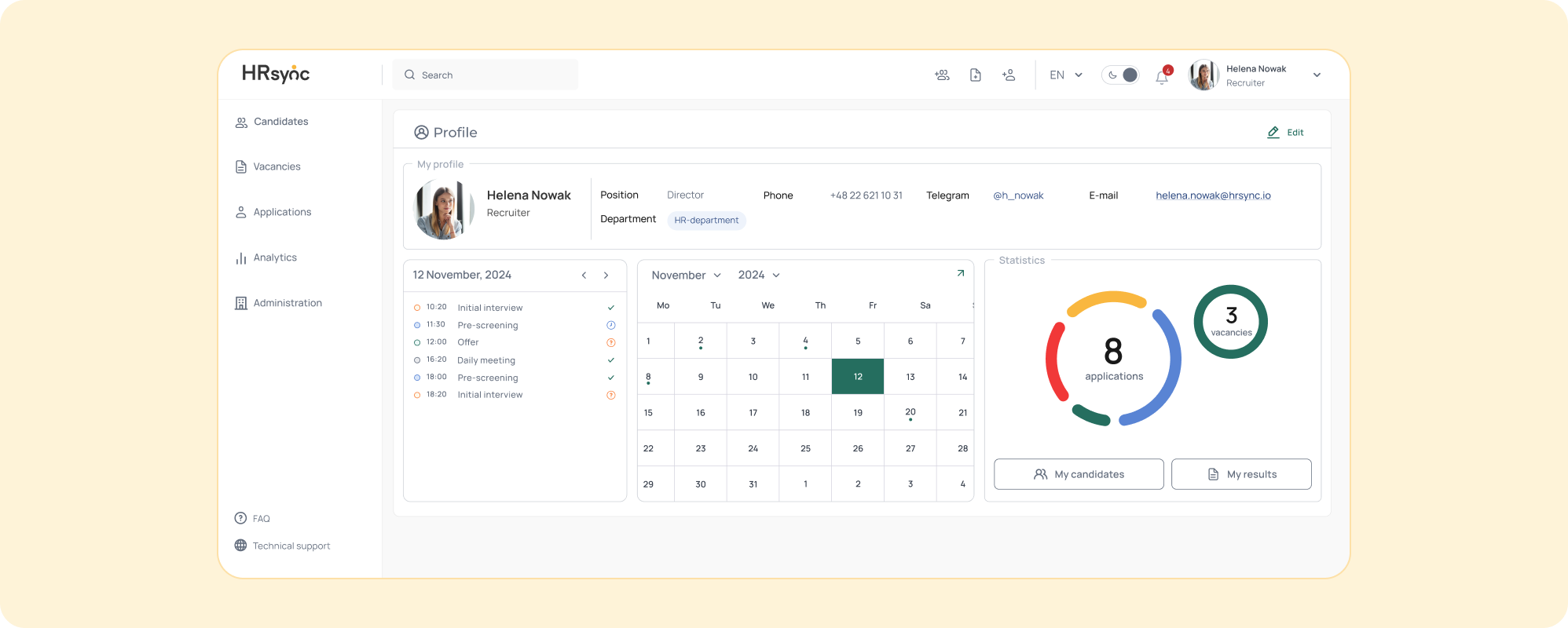
Key features and integrations
01
Candidate sourcing
The ATS integrates with LinkedIn and other similar platforms to streamline resume collection and application tracking.
02
Scheduling made simple
The ATS connects with Google Calendar for efficient interview scheduling and administrative workload reduction.
03
Real-time communication
Telegram integration allows recruiters to communicate with candidates more promptly and efficiently.
04
Corporate website support
The ATS enables seamless job posting and application management via the platfotm.
05
Data-driven insights
The ATS offers detailed reporting tools to improve hiring strategies and support decision-making.
Pros
- Significant reduction in time-to-hire (up to 50%).
- High ROI within 24 months of implementation.
- Comprehensive integrations with tools essential for recruitment workflows.
- On-premise deployment ensures robust data security and compliance.
- Intuitive interface that boosts recruiter productivity.
Cons
- Requires initial setup and infrastructure for on-premise deployment.
- May not be ideal for smaller businesses due to the focus on larger HR teams or high-volume hiring needs.
Best for: Large HR teams, recruiting agencies, and companies with active hiring needs.
Pricing: HRsync ATS is an on-premise solution that provides full control over infrastructure and data. Pricing is tailored to individual business needs to ensure scalability and flexibility for companies of all sizes.
Out-of-box ATS for fast and efficient hiring
2. Greenhouse

Key features and integrations
01
Structured workflows
Greenhouse helps organizations implement standardized hiring processes, which can be beneficial for managing large teams.
02
Diversity and inclusion tools
Features like anonymized resume reviews and scorecards are specially designed to reduce bias during hiring decision making.
03
Collaboration-focused design
Tools for feedback sharing and interview planning enhance team alignment throughout the hiring process.
04
A bunch of integrations
With over 300 connections to tools like LinkedIn, Slack, and various HRIS platforms, Greenhouse supports a wide range of workflows.
05
Analytics and reporting
The ATS provides detailed data on hiring performance, which is vital for companies with advanced recruitment metrics already in place.
Pros
- Offers extensive customization options for structured hiring.
- Strong tools for promoting inclusive recruitment practices.
- Wide range of integrations for larger, complex organizations.
Cons
- Designed primarily for enterprises, making it less flexible for smaller teams or those with limited hiring needs.
- The feature-rich design may require significant onboarding time.
Best for: Enterprises and large organizations with established hiring teams and a focus on structured, standardized recruitment.
Pricing: Greenhouse offers subscription-based pricing tailored to enterprise needs, starting from $6,500/year.
3. Workday HCM
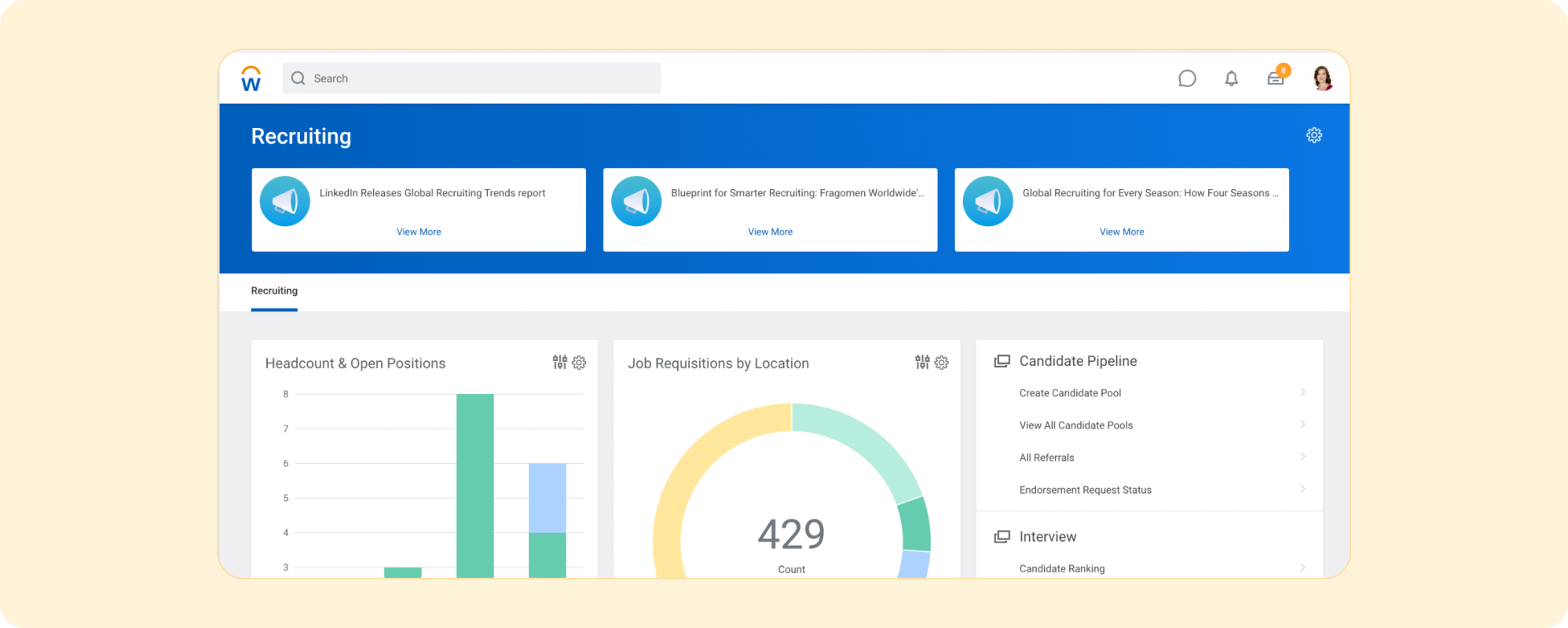
Key features and integrations
01
All-in-one HR suit
Workday HCM integrates talent acquisition with onboarding, payroll, and workforce management.
02
Global compliance
The system simplifies compliance with regional hiring laws and regulations.
03
AI-driven recruitment.
Provides intelligent candidate matching and workflow automation for smoother hiring processes.
04
Scalability and flexibility
Built to support complex company structures, it’s ideal for businesses with large, dynamic teams.
05
Mobile accessibility
A user-friendly mobile interface makes it easy for hiring managers to access the platform on the go.
Pros
- Comprehensive HR capabilities beyond recruitment.
- Strong focus on compliance for global operations.
- Scalable design for large, complex organizations.
Cons
- Extensive features can be overwhelming for businesses that primarily need an ATS.
- Higher costs may limit accessibility for smaller or mid-sized companies.
Best for: Large enterprises with global operations and businesses looking for an all-encompassing HR solution.
Pricing: Workday HCM uses a subscription-based pricing model tailored to enterprise needs. The price starts from $34-42/month per user.
4. iCIMS Talent Cloud
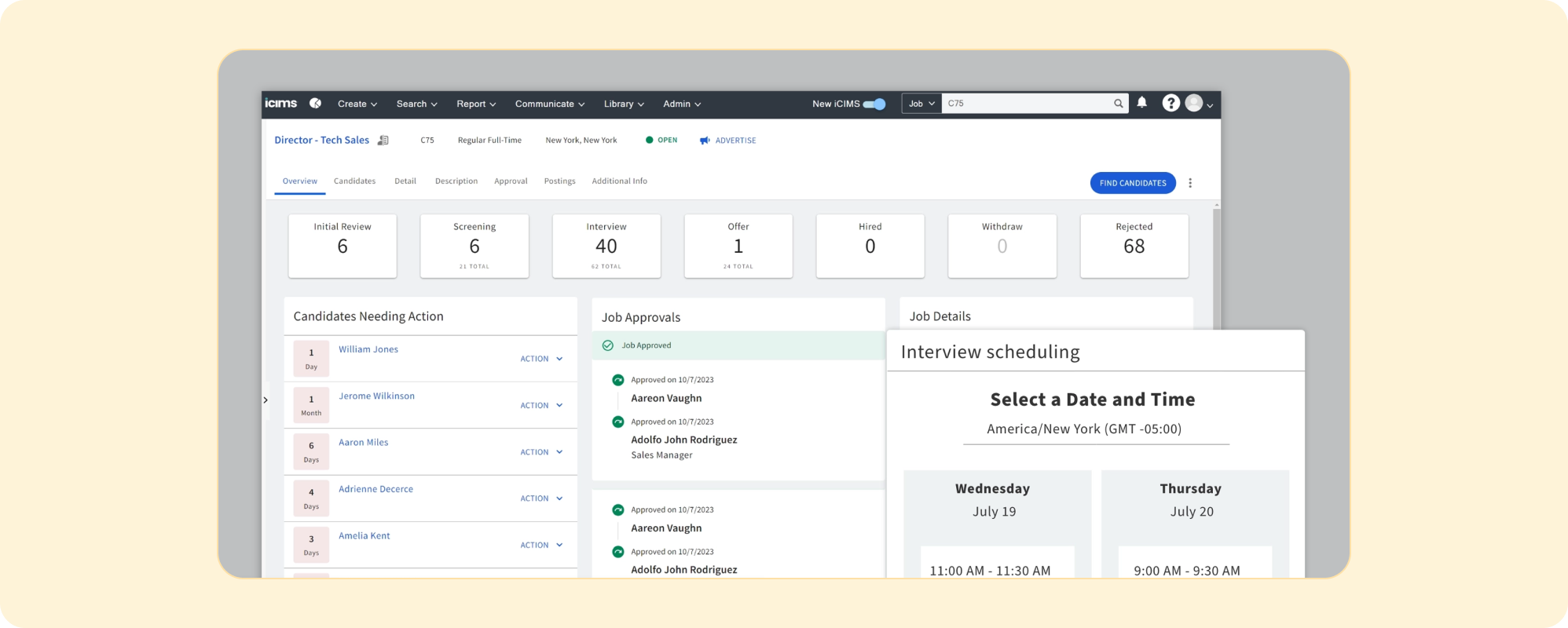
iCIMS Talent Cloud is an enterprise-grade solution designed to manage large-scale recruitment processes. With its focus on talent engagement and scalability, iCIMS offers a wide range of tools to attract, engage, and hire top talent.
Note that its comprehensive feature set and modular pricing can make it more suitable for businesses with established HR ecosystems rather than those looking for a streamlined, recruitment-focused system.
Key features and integrations
01
Talent management
Engagement tools help build and maintain a pipeline of qualified candidates.
02
Customizable career portals
You can create branded career site to show your company culture and attract top talent.
03
Video interviewing tools
iCIMS has decent integrated video solutions to simplify remote hiring processes.
04
Comprehensive integrations
The tool supports connectivity with major HRIS platforms, job boards, and productivity tools to fit into complex HR ecosystems.
05
Advanced analytics
Detailed insights into recruitment metrics like time-to-hire and cost-per-hire help businesses refine their strategies.
Pros
- Scalable and customizable for large enterprises.
- Excellent talent engagement tools to nurture long-term candidate relationships.
- Integration capabilities with existing HR infrastructure.
Cons
- Modular pricing can lead to higher costs for businesses needing multiple features.
- May feel overly complex for companies focused solely on recruitment efficiency.
Best for: Enterprises with established HR ecosystems, organizations focused on talent engagement and pipeline management, and companies with complex recruitment needs.
Pricing: iCIMS operates on a modular pricing model, which can scale with an organization’s needs but may result in higher costs. Minimal price is $1,700/month.
5. BambooHR

BambooHR is a versatile platform that combines applicant tracking with broader HR management tools. Its simplicity and ease of use make it one of the most popular ATS for small to medium-sized businesses. However, its focus on general HR functions may not fully meet the needs of companies seeking advanced recruitment capabilities or high-volume hiring solutions.
Key features and integrations
01
Streamlined ATS tools
You can manage job postings, track applicants, and collaborate with hiring teams easily.
02
Employee onboarding
Special workflows and eSignature functionality simplify the transition from candidate to employee.
03
Mobile accessibility
A mobile app lets recruiters efficiently track and manage tasks anytime, anywhere.
04
Integrated HRIS features.
The ATS is combined with HRIS for payroll, performance tracking, and benefits management.
05
Reporting and analytics
The tool provides basic insights into hiring metrics like time-to-fill and candidate sources.
Pros
- Extremely straightforward interface, ideal for smaller teams.
- Combines recruitment with broader HR tools in a single platform.
- Affordable pricing tailored for SMBs.
Cons
- Limited advanced features for high-volume or complex recruitment needs.
- Focus on general HR functions may dilute its effectiveness as a dedicated ATS.
Best for: Small to medium-sized businesses, companies looking for an entry-level ATS integrated with HR tools, and teams prioritizing simplicity over advanced recruitment features.
Pricing: BambooHR offers a subscription-based pricing model tailored to SMBs. The price range is from $12 to $22 per user per month.
Need an ATS that aligns with your company’s hiring process?
We’ll customize HRsync ATS to fit your exact requirements.
6. Zoho Recruit
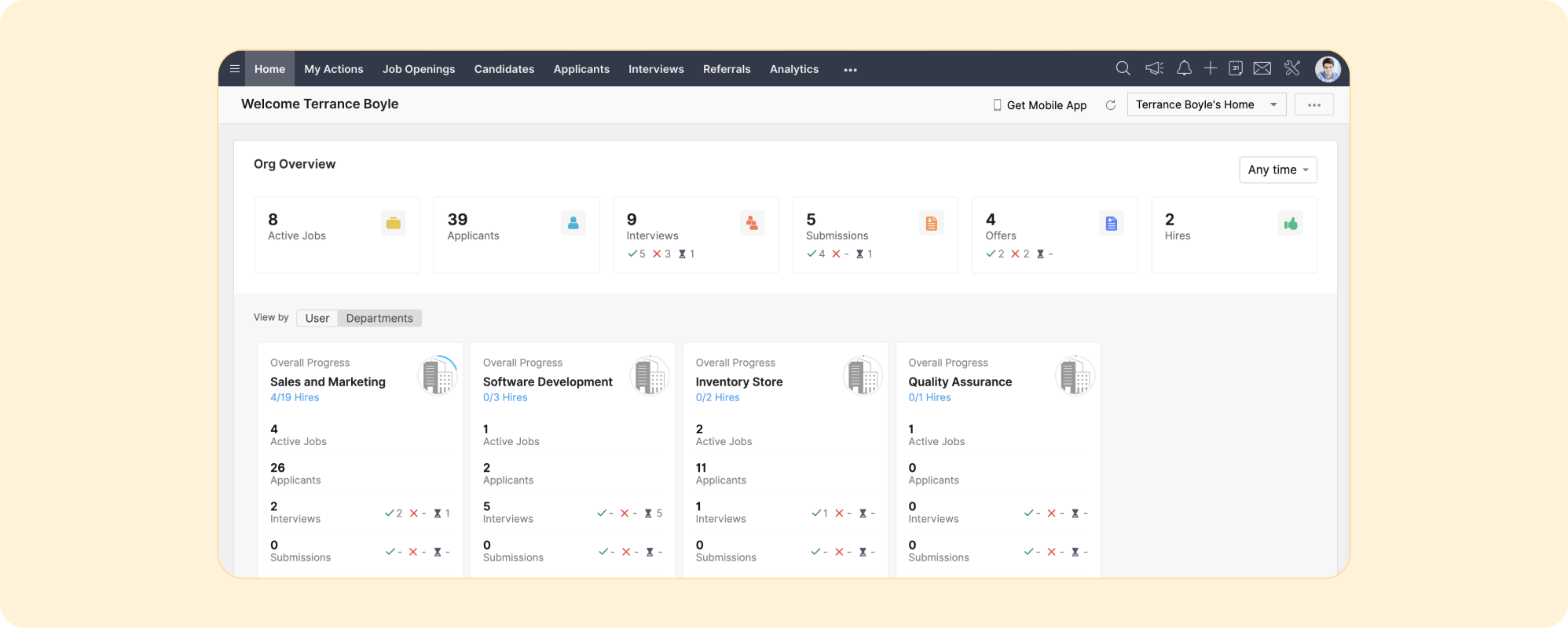
Zoho Recruit is an adaptable and cost-effective applicant tracking system built with small to mid-sized businesses and staffing agencies in mind. It puts a strong emphasis on customization and automation, which makes it an appealing option for companies working within a tighter budget.
That said, it might not be the best applicant tracking system for organizations managing large-scale recruitment efforts or the ones in need of enterprise-grade capabilities.
Key features and integrations
01
Customizable workflows
You can adapt recruitment pipelines, application forms, and communication templates to match specific hiring processes.
02
Multi-channel job posting
With the tool, you can post vacancies across platforms like LinkedIn, Indeed, and Glassdoor with a single click.
03
AI-driven candidate matching
There are intelligent tools to identify the best-fit candidates based on relevant skills for more successful hiring.
04
Automation tools
The ATS automates repetitive tasks like follow-ups, reminders, and status updates, saving time for recruiters.
05
Basic reporting
It provides insights into key metrics such as candidate sources and time-to-fill.
Pros
- Highly customizable and easy to set up.
- Budget-friendly pricing plans, including options for small businesses.
- Automation tools reduce administrative workload.
Cons
- Limited scalability for organizations with high-volume hiring needs.
- Advanced features, like in-depth analytics, may require higher-tier plans.
Best for: Small and mid-sized businesses, staffing agencies, and teams with moderate recruitment needs looking for a customizable and cost-effective ATS.
Pricing: Zoho Recruit offers flexible pricing plans starting from $25/month per user, including a free tier for basic needs.
7. Lever
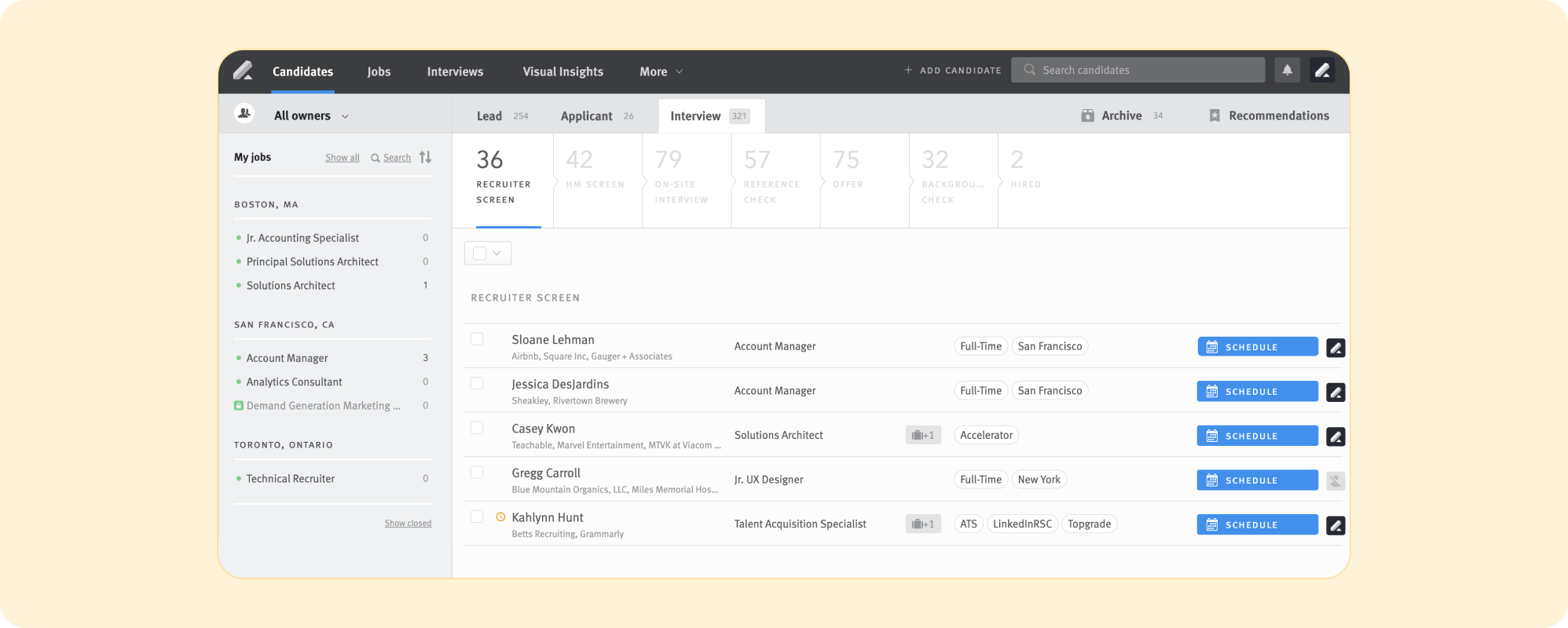
Lever combines the functionalities of an applicant tracking system and a customer relationship management tool. It emphasizes talent engagement and collaboration, making it a strong option for mid-sized to large businesses.
However, its feature-rich interface and pricing structure may not appeal to smaller teams or those prioritizing simplicity over depth.
Key features and integrations
01
Integrated ATS and CRM
With the ATS, you can manage active job openings while maintaining relationships with passive candidates for future roles.
02
Nurture campaigns
You can automate and personalize follow-ups to keep candidates engaged throughout the hiring process.
03
Collaborative tools
The system facilitates seamless communication within hiring teams through shared candidate feedback and centralized workflows.
04
DEI insights
There are analytics to promote diversity, equity, and inclusion in hiring practices.
05
Robust integrations
You can connect the LMS with LinkedIn, Google Workspace, Slack, and HRIS platform.
Pros
- Combines ATS and CRM capabilities for a holistic approach to recruitment.
- Strong focus on candidate engagement and proactive talent pipeline management.
- DEI-focused tools support inclusive hiring initiatives.
- Advanced features may require a learning curve for new users.
- Pricing may not be ideal for smaller businesses or those with simpler hiring needs.
Best for: Mid-sized to large companies, organizations with an emphasis on building talent pipelines, and businesses seeking tools for DEI-focused hiring.
Pricing: Lever offers tailored pricing plans based on company size and recruitment needs. The average cost is about $24,000 per year.
8. Workable

Workable is an applicant tracking system that supports rapid hiring and global recruitment efforts. Its intuitive interface and AI-powered features make it a go-to option for businesses looking to scale quickly.
However, while it offers flexibility and accessibility, Workable may not suit organizations requiring more robust data security or specialized recruitment workflows.
Key features and integrations
01
AI-powered candidate sourcing
The tool suggests top candidates based on job descriptions, saving time on manual searches.
02
One-click job posting
You can publish job listings across over 200 job boards and social media platforms in a couple of clicks.
03
Built-in video interviews
The ATS simplifies remote hiring with video interviews you can hold right on the platform.
04
Customizable pipelines
You can adapt hiring workflows to align with your organization’s specific recruitment stages.
05
Global hiring support
There are localized job ad templates and compliance tools for international hiring.
Pros
- User-friendly design that minimizes the learning curve.
- AI-driven tools to speed up sourcing and candidate matching.
- Scalable options for growing businesses with global hiring needs.
Cons
- Limited data control and security compared to on-premise solutions.
- May not offer enough depth for highly specialized or complex recruitment workflows.
Best for: Startups, small to medium-sized businesses, and organizations hiring at scale across multiple regions.
Pricing: Workable offers flexible pricing with pay-as-you-go and annual subscription options starting from $149/month.
9. JazzHR
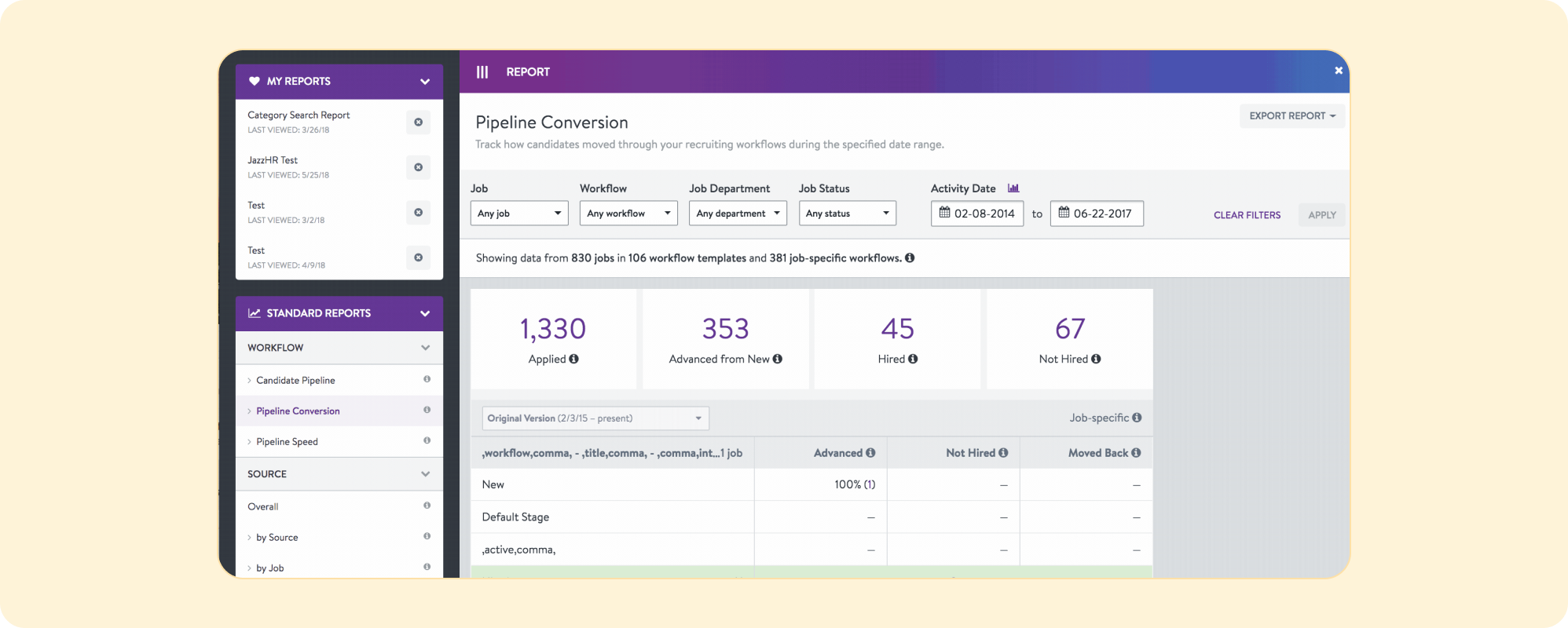
JazzHR is a straightforward and affordable applicant tracking system designed with small businesses and startups in mind. Its focus on simplicity and essential features makes it a popular choice for teams looking to manage hiring without overwhelming resources.
However, JazzHR’s limited advanced capabilities may not meet the needs of larger organizations or those handling complex hiring processes.
Key features and integrations
01
Simplified job posting
You can easily advertise job openings on platforms like LinkedIn, Indeed, and Glassdoor.
02
Customizable workflows
With the tool, you can adapt hiring pipelines to match your recruitment process.
03
Candidate self-scheduling
Candidates can schedule interviews directly, reducing administrative back-and-forth.
04
Collaboration tools
You can share feedback and notes with your team to streamline hiring decisions.
05
Employer branding
You can customize career pages to reflect your company culture and attract top talent.
Pros
- Affordable pricing plans tailored for small teams and startups.
- Easy-to-use interface with minimal setup required.
- Basic features cover the essentials of hiring without unnecessary complexity.
Cons
- Limited scalability for high-volume recruitment needs.
- Lacks advanced features like in-depth analytics or AI-driven tools.
Best for: Startups, small businesses with modest hiring needs, and teams prioritizing ease of use and cost-effectiveness.
Pricing: JazzHR offers budget-friendly tiered pricing plans starting from $75/month.
10. Bullhorn ATS
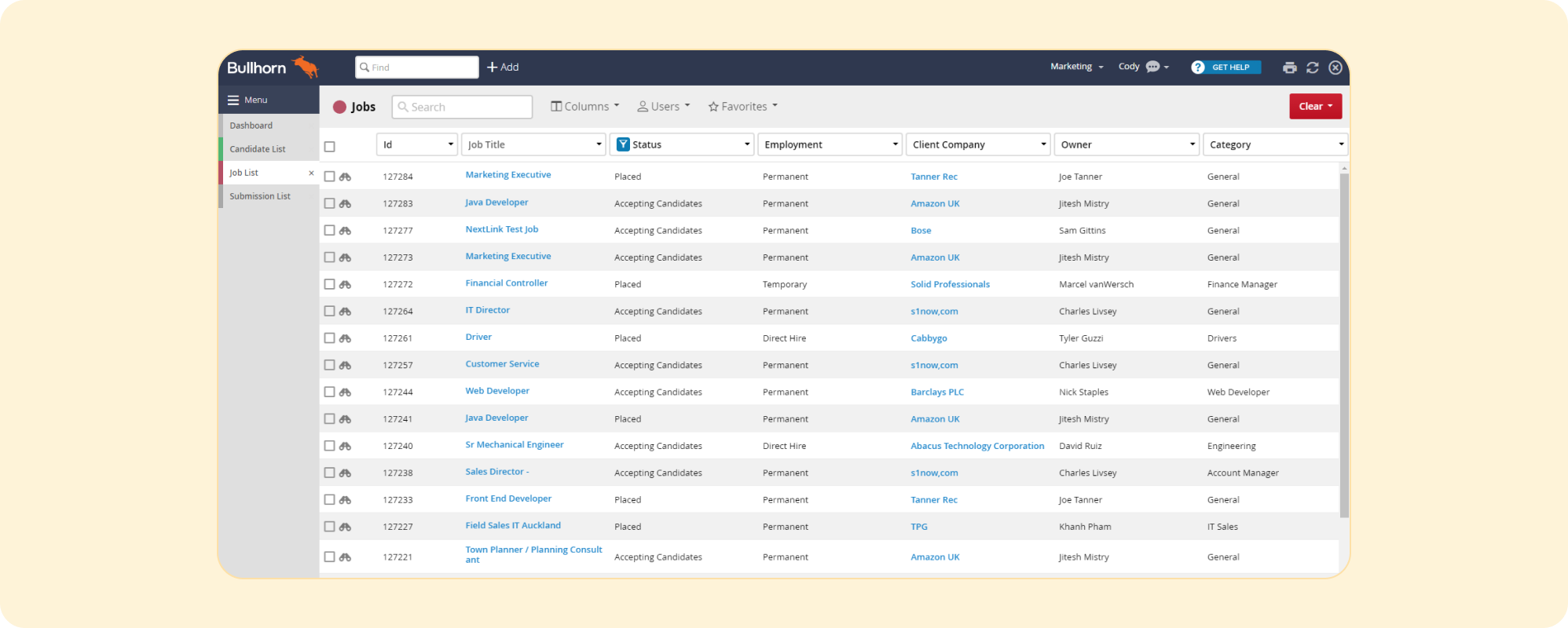
Bullhorn ATS is the best applicant tracking system for staffing agencies. Known for its robust CRM integration, Bullhorn provides recruiters with the tools to manage candidate pipelines, build client relationships, and automate repetitive tasks.
While its robust features suit high-volume hiring, its complexity and cost may not be ideal for in-house HR teams or smaller organizations.
Key features and integrations
01
Integrated ATS + CRM
You can manage candidates and client relationships in one platform for streamlined operations.
02
Automated workflows
You can automate email follow-ups, interview scheduling, and job postings to save time.
03
Customizable dashboards
The tool allows you to visualize data and track key metrics, such as time-to-fill and placement rates.
04
Resume parsing
You can extract key details from resumes and organize them into a searchable format.
05
VMS (Vendor Management System) integration
It simplifies the management of temporary staffing and contingent workforce needs.
06
Mobile app
You can access the platform on the go to manage recruitment tasks anytime, anywhere.
Pros
- Designed specifically for the unique needs of staffing and recruitment agencies.
- Combines ATS and CRM functionality for seamless client and candidate management.
- Scalable for handling high-volume hiring and contingent workforce needs.
Cons
- Geared more toward staffing agencies than in-house recruitment teams.
- Complexity and cost may deter smaller organizations or those with simpler hiring workflows.
Best for: Staffing agencies, recruitment firms managing high volumes of candidates, and companies needing VMS integration for contingent workforce hiring.
Pricing: Bullhorn ATS offers a scalable pricing model based on the needs of recruitment agencies, starting from $99 per month.
How to choose the best applicant tracking software
Selecting the best ATS software is critical to improving your recruitment process and achieving your hiring goals. Here are practical steps and considerations to help you identify the best ATS for your organization:
1. Define your recruitment needs and priorities
Finding the best applicant tracking system isn’t just another box to tick; it’s a way to rethink how your team approaches hiring. But how do you pick the one that genuinely meets your needs? It starts with understanding what you’re up against and what you need to solve.
Think about where the bottlenecks are. Are you buried under a mountain of applications for every role? Then you’ll need an ATS that can handle resume parsing and automated screening without breaking a sweat.
Struggling to keep recruiters and HR managers on the same page? Prioritize platforms with tools that let your team collaborate easily — share feedback, stay aligned, and avoid the dreaded email chaos.
And if your company is scaling quickly, look for a system that can grow with you, whether that means adding more users or managing more complex hiring workflows down the line.
Here’s a practical tip: make a list of must-have features versus the nice-to-haves. Talk to your recruiters — they’re the ones who’ll use the system every day. For example, if hours are being lost to manual resume sorting, put AI-driven filtering high on your priority list.
2. Focus on user experience and integration
If the system isn’t easy to use or doesn’t integrate with your existing setup, it can quickly become a frustration rather than a solution.
Think about user experience first. Is the platform intuitive enough that your team can start using it without hours of training? Top ATS software should make tasks like posting jobs, reviewing applications, or scheduling interviews feel effortless. If it feels like a chore just to navigate, adoption will be an uphill battle.
Equally important is integration. Your ATS should play nicely with the tools you already rely on — whether it’s LinkedIn for sourcing, Google Calendar for scheduling, or your HRM system. The goal is a streamlined workflow, not a patchwork of disconnected processes.
Here’s a tip: always request a demo or trial. Let your recruiters and hiring managers take the system for a test drive. Can they see it fitting into their daily work? Does it simplify their tasks or add complexity?
In addition to hands-on testing, take some time to read applicant tracking system reviews on dedicated platforms like G2 or Capterra. These reviews often highlight real-world experiences, including potential pitfalls and standout features, giving you a broader perspective.
Conclusion
At the end of the day, picking the best ATS is all about what works best for you. Whether you’re juggling tons of applications or just need a simple tool to keep things organized, the key is finding an ATS that fits your style and solves your hiring headaches.
Think about what really matters: speeding up the process, making collaboration easier, or giving candidates a better experience. Try out a few, see what clicks, and go with the one that feels like a natural part of your workflow.
Choosing the right ATS? Let’s talk!
We’ll help you find the best solution — out-of-box or customized. See how ATS by HRsync can streamline your hiring process.
FAQ
The top ATS systems in 2025 include HRsync, Greenhouse, Workday HCM, iCIMS Talent Cloud, BambooHR, Zoho Recruit, Lever, Workable, JazzHR, and Bullhorn ATS. Each offers unique features tailored for different business sizes and hiring needs, from scalable enterprise solutions to affordable tools for small businesses.
Focus on your recruitment challenges and goals. Look for features like automation, collaboration, and analytics that align with your needs. Ensure the system integrates with your existing tools, offers scalability, and is easy for your team to use. Read applicant tracking systems reviews, test demos, or get trials before committing.
The top applicant tracking systems save time on repetitive tasks, improve candidate tracking, enhance collaboration among hiring teams, and provide insights through reporting. They streamline workflows, reduce time-to-hire, and improve the candidate experience.
Industries with high recruitment demands, such as tech, healthcare, retail, and staffing agencies, benefit most. ATS systems are also valuable for fast-growing businesses and organizations hiring across multiple regions.
Yes, the best applicant tracking systems for recruiters, like HRsync, Zoho Recruit, and JazzHR, offer customizable workflows, pipelines, and templates to fit unique hiring processes. Some even provide options for branded career pages and tailored reporting.
Get a free consultation and learn how HRsync’s turnkey solutions can optimize your company’s HR processes.
